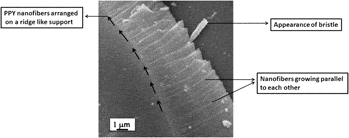Article contents
Growth of one-dimensional doped polypyrrole nanofibers on glass substrate
Published online by Cambridge University Press: 26 November 2012
Abstract

One-dimensional (1D) nanofibers of polypyrrole (PPY) are fabricated on glass substrates in the presence of different dopants, namely, hydrochloric acid (HCl), ferric chloride (FeCl3·6H2O), p-toluene sulfonic acid, camphor sulfonic acid, and polystyrene sulfonic acid using a simple in situ vapor phase chemical oxidative polymerization method. Preliminary morphological details investigated using light microscopic study reveal 1D configuration for all the doped PPY structures, indicating a fibrous/tubular appearance. Furthermore, scanning electron microscopy confirms preferential growth of these PPY structures as fine fibers arranged in a brush-/comb-like pattern, having an average diameter of 70 nm. Such brush-like growing pattern observed for the PPY nanostructures without the aid of nanoporous membranes and/or sophisticated techniques is not very commonly reported in the literature. The undertaken work suggests applications of nanodimensioned fabricated PPY structures in the practical nanodevices and/or functional glass for sensing, optoelectronic, photocatalysis, and solar energy systems.
Information
- Type
- Articles
- Information
- Copyright
- Copyright © Materials Research Society 2012
References
REFERENCES
- 2
- Cited by

